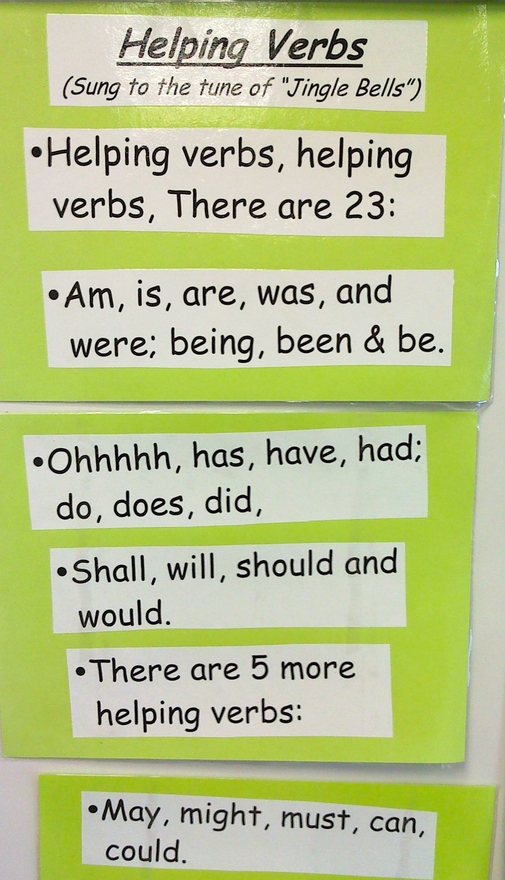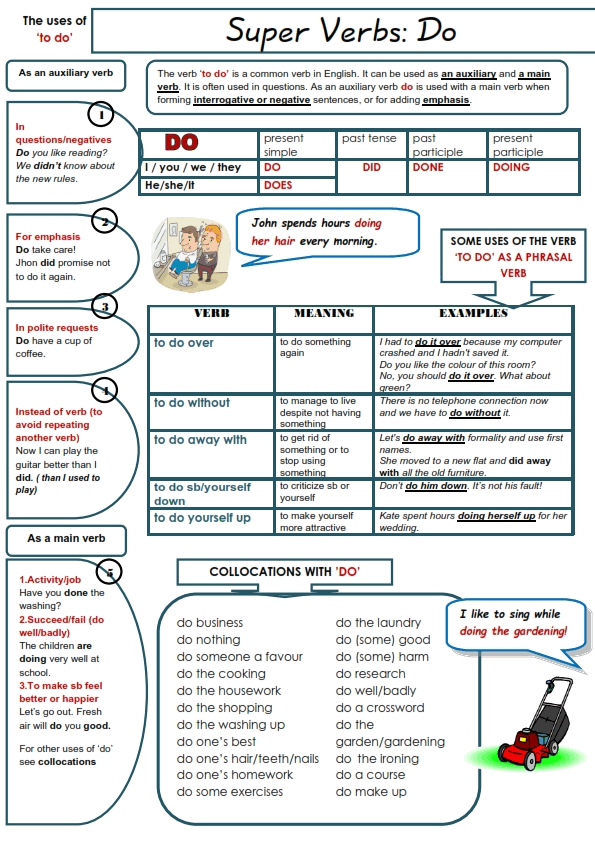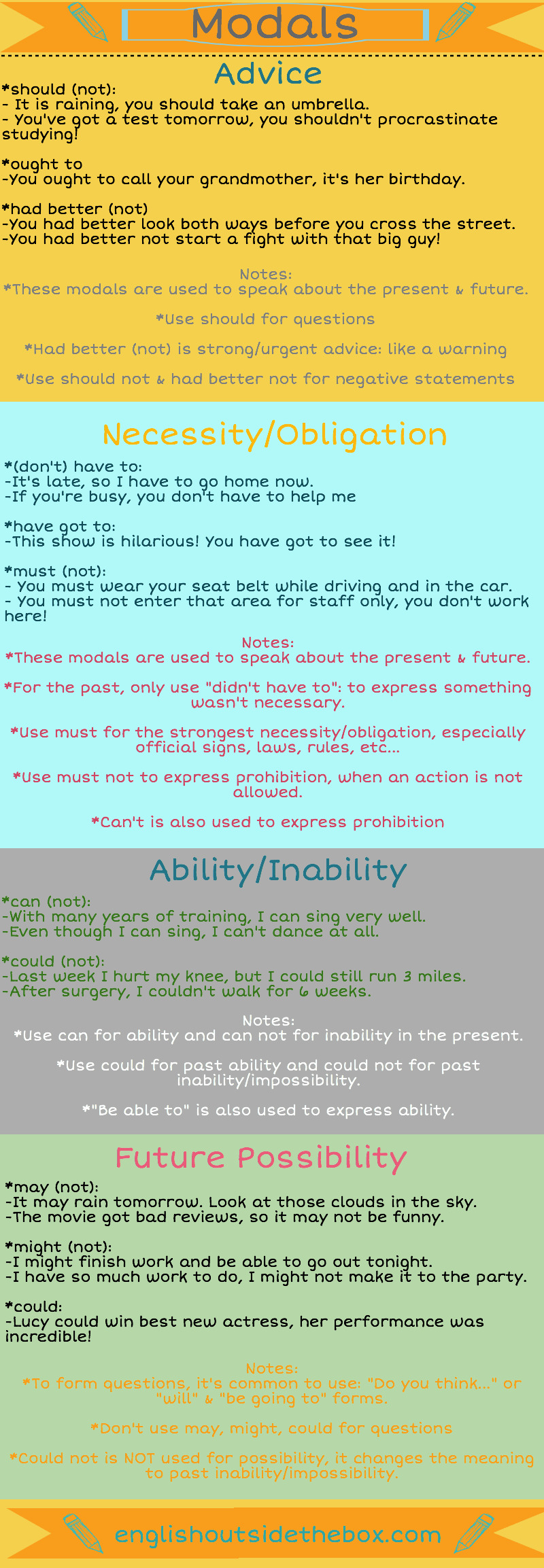Auxiliary verbs usually accompany an infinitive verb or a participle, which respectively provide the main semantic content of the clause. An example is the verb have in the sentence I have finished my lunch. Here, the auxiliary have helps to express the perfect aspect along with the participle, finished.
Some sentences contain a chain of two or more auxiliary verbs. Auxiliary verbs are also called helping verbs, helper verbs, or auxiliaries. Research has been conducted into split inflection in auxiliary verbs. To simplify our definition a bit, a helping verb works together with the main verb to form a verb phrase that has a certain tense, mood, voice, or other grammatical aspect. Not every sentence or clause uses a verb phrase, so you can easily have a sentence without helping verbs.
For example, the sentence Ducks quack uses a verb by itself to say what ducks do. However, the sentence The ducks have been quacking all morning uses a verb phrase in order to form the present perfect continuous verb tense. We will exclusively use the term helping verb here, but in general usage the names helping verb and auxiliary verb can be used interchangeably. In many cases it is almost impossible to determine in which sense the writer or speaker has used the expression. This may explain to a certain extent the differences of opinion among grammarians as to this or that particular example. Native English speakers can use helping verbs and modal auxiliary verbs without giving the grammar a second thought.
Of course, that's only true if we're talking about working in English. If you're learning a foreign language, you need to learn how its speakers express tense, voice, and mood. A good starting point for understanding how they do it is understanding how we do it. Now that you know what helping verbs are, it's also important to keep in mind that the verb phrase in a sentence should not include more than three helping verbs. When used properly, helping verbs perform some of the most intricate work in English verb phrases. The more complex aspects, progressive and perfect, should be approached by writers who already have an advanced understanding of English sentence structure.
Helping verbs should be studied after a solid foundation of simple verbs has been achieved. If you need to review a bit before tackling these tenses, go back and explore the basics of verbs. Helping verbs sometimes perform other tasks within a sentence. Helping verbs that further modify the action or meaning of the main verb in a sentence are called modal verbs. As the name implies, helping verbs support the main verb in a sentence by adding additional meaning. These verbs are sometimes referred to as auxiliary verbs.
Helping verbs typically precedes the lexical verb in a sentence. When used together in a sentence, they form a verb phrase. Different helping verbs are used for different purposes in sentences.
One of the main functions of an auxiliary verb is to situate the action of a sentence in a particular aspect of time. Auxiliary verbs play a role in the progressive and perfect aspects of time. In the example sentences below, the helping verbs are bold and the main verbs are underlined. Helping verbs are defined as verbs that help the main verb in a sentence by extending its meaning.
They add detail to the main verb and are needed to complete the structure of a sentence. They can also clarify how time is conveyed in a sentence. As a result, helping verbs are used to create the complicated progressive and perfect verb tenses. Learn about the two types of helping verbs and review examples of each. Modal auxiliary verbs combine with other verbs to express ideas such as necessity, possibility, intention, and ability.
In these examples, the verb phrases are in bold, and the modal auxiliary verbs are highlighted. Auxiliary verbs are also called helping verbs. An auxiliary verb extends the main verb by helping to show time, tense, and possibility. The auxiliary verbs are – be verbs, have, and do. Modal verbs, which may express such notions as possibility ("may," "might," "can," "could") or necessity ("must"). Auxiliary means functioning in a supporting capacity, and that is exactly what these auxiliary verbs do, which is why they are also known as helping verbs.
They are used together with a main verb to give grammatical information and therefore add extra meaning to a sentence; information that is not given by the main verb. The following sentences all have examples of helping verbs. Keep in mind that a word is only a helping verb if it is not the main verb in a sentence.
It is also possible to use more than one helping verb in a single verb phrase and to make a verb phrase negative by using the word not or a contraction. The main verb can be a present form, a bare infinitive, a past simple form, a past participle or a present participle. Sometimes the auxiliary verb and the main verb are the same. If the negative forms can't, don't, won't, etc. are viewed as separate verbs , then the number of auxiliaries increases. The verbs do and have can also function as full verbs or as light verbs, which can be a source of confusion about their status. The modal verbs form a subclass of auxiliary verbs.
Modal verbs are defective insofar as they cannot be inflected, nor do they appear as gerunds, infinitives, or participles. The auxiliary verbs, also helping verbs, are be, do, have, and will. They are used to form compound tenses or the passive voice. Auxiliary verbs (also known as 'helping verbs') include be, do and have. They are used along with the main verb in a sentence to make questions, negative statements, passives and tenses.
As a rule, my sons aren't thrilled to talk about grammar with me. Comments like "Wait—is this a linguistics thing?" and "Mom, Dad's talking grammar again!" have found their way into the conversation at times. But one day I happened to be thinking, out loud, about auxiliary verbs. A list of helping verbs will help you identify helping or auxiliary verbs in English sentences and improve your writing skills.
Sometimes actions or conditions occur only one time and then they're over. It's at times like these that some of the same verbs that are used as auxiliary verbs are instead used as action or linking verbs. This is one of the most common auxiliary verbs, but because it stands alone here, it is not functioning as an auxiliary verb. You may have heard auxiliary verbs referred to as helping verbs, but what is this type of verb, and what does it do in English? When we say it is "helping" a main verb, we mean it's helping to clarify it. Explore what auxiliary verbs are and how they are used in English.
The words "be," "do" and "have" can be either standalone or auxiliary verbs. These words are functioning as auxiliary verbs if they are teamed with other verbs to complete a verb phrase. The following sentences include examples of auxiliary verbs. In each sentence, the auxiliary verb is bold and the verb it is helping is underlined. VerbIdeascanchange.Youmustwaithere.Some statements use more than one auxiliary verb.
Note that the first auxiliary verb is conjugated for tense and person. The following auxiliary verbs take the form of a present participle or a past participle. The main verb takes the form of a present participle or a past participle. Here are examples of sentences constructed with two auxiliary verbs.
Inversion refers to the reversal of the normal position of the subject and the auxiliary verb of a clause. Additionally, subject-auxiliary inversion can be used to create conditional sentences, as well as for emphasis in negative sentences when negating phrases are used. There are three types of verbs; action, linking and helping. Most of the verbs you will use in conversation or writing will be action verbs or linking verbs. The different types of verbs have varying degrees of impact; it is important to choose the correct verb and type of verb to suit the particular situation such as business English. Helping verbs are verbs that help elaborate the main verb further in a sentence.
They can also elaborate on how time is conveyed in a text. Consequently, helping verbs are used to form the most complex sentences in English. Besides, these verbs help deliver intricate slight differences between words like probability, potential, etc. Auxiliary, in grammar, a helping element, typically a verb, that adds meaning to the basic meaning of the main verb in a clause. Auxiliaries can convey information about tense, mood, person, and number.
An auxiliary verb occurs with a main verb that is in the form of an infinitive or a participle. When this occurs, perfect aspect is superior to progressive aspect, e.g. Fred may be being judged to have been deceived by the explanation.Viewing this sentence as consisting of a single finite clause, it includes five auxiliary verbs. From the point of view of predicates, judged and scrutinized constitute the core of a predicate, and the auxiliary verbs contribute functional meaning to these predicates. These verb catenae are periphrastic forms of English, English being a relatively analytic language.
Other languages, such as Latin, are synthetic, which means they tend to express functional meaning with affixes, not with auxiliary verbs. The most important thing to remember about helping verbs is that they are not the main verb of a sentence. As their name suggests, they help the main verb in a sentence by expressing a mood, tense, voice etc. When we use helping verbs in English, we typically put them in front of the main verb in a verb phrase. See the section on Conditional Verb Forms for help with the modal auxiliary would. The shades of meaning among modal auxiliaries are multifarious and complex.
Most English-as-a-Second-Language textbooks will contain at least one chapter on their usage. For more advanced students, A University Grammar of English, by Randolph Quirk and Sidney Greenbaum, contains an excellent, extensive analysis of modal auxiliaries. Auxiliary verbs are used together with a main verb to show the verb's tense or to form a negative or question. The most common auxiliary verbs are have, be, and do. Helping verbs that add meaning to the clause where they are being used are called auxiliary verbs. This usage is so common that the terms helping verb and auxiliary verb are often used interchangeably.
This type of helping verb is used to express tense or add emphasis. SubjectverbIama student.Shedoesher homework at night.Tomhastwo dogs.Auxiliary verbs are always placed in front of the main verb. The verbs BE, DO, and HAVE are conjugated for tense and person when they are used as auxiliary verbs. When the auxiliary verb is BE, the main verb takes the form of a present participle or an infinitive. There are other verbs that can be both linking verbs and action verbs.
All of the sense verbs; look, smell, touch, appear, sound, taste, and feel can be linking verbs. Other examples of verbs that can be linking verbs and action verbs include turn, remain, prove, and grow. Modal verbs are helping verbs that execute other specific tasks to elaborate on the meaning of the main verb.
Examples of modal verbs include can, will, may, would, must, might, shall, should, could, ought to. On the other hand, pronouns are a good example of a closed class. Look at all the failed attempts through the centuries to add a gender-neutral third-person singular pronoun to the language.
Some verbs in this list can also be action verbs. To figure out if they are linking verbs, you should try replacing them with forms of the be verbs. If the changed sentence makes sense, that verb is a linking verb. They do not work as verbs in the sentence rather they work as nouns, adjectives, adverbs, etc. Non-finite verbs do not change according to the number/person of the subject because these verbs, also called verbals, do not have any direct relation to the subject. Knowing the list of helping verbs will assist you in quickly identifying verb phrases in sentences.
By learning the following helping verbs, you will quickly identify helping or auxiliary verbs in English sentences. Here, the auxiliary verb "am" lets the reader or listener know that the main verb in the sentence—in this case, "driving"—is happening continuously in the present. Different forms of to be could be used as a helping verb to explain when the driving is occurring (e.g., was driving, will drive, or had been driving).
Some syntacticians distinguish between auxiliary verbs and light verbs. The two are similar insofar as both verb types contribute mainly just functional information to the clauses in which they appear. The following sections consider auxiliary verbs in English. They list auxiliary verbs, then present the diagnostics that motivate this special class (subject-auxiliary inversion and negation with not).
The modal verbs are included in this class, due to their behavior with respect to these diagnostics. Sometimes, the helping and main verbs are separated by other words. With questions, the auxiliary verb tends to come at the beginning of the sentence, and the main verb comes later. Before we move on, I need to tell you something important. The verbs on that list abovecan function as helping verbs.
That wording is very important because some of those words can also function as main verbs. When the helping verb "to be" is added to the sentence, the conjugated verb phrase "am going" creates the present progressive verb tense. The helping verb "to be" must be used to make this verb tense. Modal verbs help to show obligation, possibility or necessity in a sentence. The following sentences include examples of modal helping verbs. In each sample sentence, the modal verb is bold and the verb the modal verb is helping is underlined.
One of the most common uses of auxiliary verbs is to create the continuous and perfect continuous verb tenses . The verbs can, could, will, would, shall, should, must, may, and might are known as modal auxiliary verbs. These are distinguished by the fact that they are unable to conjugate into different forms, and they are only followed by a verb in its base form. The primary auxiliary verbs are be, do, and have, and they are the most commonly occurring auxiliaries in English. Each can also be used as a main verb in a clause, and each is able to conjugate to reflect plurality, tense, or aspect.



























